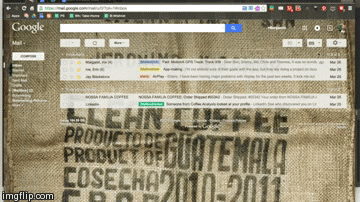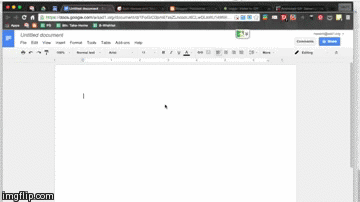I am reading Enhancing the Art and Science of Teaching with Technology (Marzano, Page 37). Here is some interesting data in reference to John Hattie's (2009) meta-analyses and studies on student achievement with the use of educational technology.
Monday, March 30, 2015
Friday, March 27, 2015
Accessing Gmail Labs
Gmail offers some helpful gadgets that you can add to your email experience and provide some functionality to increase productivity. You can access Labs from Settings.
Friday, March 20, 2015
Google App Launcher
Did you know you can go straight to your Docs/Sheets/Slides from the App launcher? Here's how: http://t.co/YqVhR5nQO8 pic.twitter.com/fd8O1FhI0a
— Google Docs (@googledocs) March 19, 2015
Thursday, March 19, 2015
Formative Assessment: Ditch The Worksheets
I came across this article from +Edutopia written by +Vicki Davis and had to feature it here. She talks about her experiences with really understanding where your students are at with their learning progress and how so many times our "teacher instinct' isn't as tuned in as we would like to think.
Vicki presents some ways for collecting formative assessment of your students through the use of very simple tech tools. According to the SAMR model, tech should be used to assist and transform learning. When utilizing electronic formative assessments like this, not only are you just substituting a standard pop-quiz, but with the instant feedback from the programs you are adding modification to your tech use, providing the students with enriched learning and more engagement; better mastery.
Review this article (link below) and try at least one of these for a unit or a small lesson in a classroom that you would feel the most comfortable in learning a new product.
Vicki presents some ways for collecting formative assessment of your students through the use of very simple tech tools. According to the SAMR model, tech should be used to assist and transform learning. When utilizing electronic formative assessments like this, not only are you just substituting a standard pop-quiz, but with the instant feedback from the programs you are adding modification to your tech use, providing the students with enriched learning and more engagement; better mastery.
Review this article (link below) and try at least one of these for a unit or a small lesson in a classroom that you would feel the most comfortable in learning a new product.
Thursday, March 12, 2015
Google Calendar: How to Create and Reserve Appointment Slots
This is a great feature that I bet many do not know was there.
Using Online Quizzes and Grading
I recently re-tweeted an article by +Alice Keeler, but thought it worth highlighting here. Alice discusses some great models she uses to eliminate the time-consuming worksheets (paper or digital) and uses online applications to administer quizzes. The focus here is student-centered!
You can see Alice's original article here.I have received several tweets about how cumbersome it is to have students work with PDF’s in a digital format. I am going to be blunt, uploading your worksheets to PDF’s and putting them online is not a 21st century lesson. This is substitution on the SAMR model. It is a pain to manage digital worksheets. May I take this opportunity to suggest that is because you should not be doing this.Using technology should create a BETTER learning environment. If you are doing the same tasks with technology you should expect the same educational outcome. Rethink when using tech how you can change what you do. How the task can be more student centered. Allow for more creativity. How do digital tools allow you to differentiate and personalize the instruction? How do digital tools allow your students to become independent learners?If The Computer Can Grade It, It Should
One of the advantages to digital work is the ability for students to receive feedback faster. Instead of uploading worksheets to your website, Google Classroom or your LMS for students to fill out consider instead recreating the worksheets in Google Forms, That Quiz, Quia, or any of the many other online tools for administering quizzes. Do a Google Search for “online quiz” and several options come up.If the questions are DOK 1 or DOK 2 a computer can probably grade it. It is significantly more motivating to students to immediately receive feedback on their progress. Rather than do an entire worksheet of problems, wait for the teacher to grade it and give them their scores back, online quiz tools can provide students with feedback immediately after every question or at the completion of the questions. This is win win. The students are more motivated and receive their scores immediately. Teachers save time grading. The quiz generators often have data that the teacher can then look at to see what percentage of the class are being successful, how long it is taking them to do the work, and more quickly target students that need help.I typed up all of my worksheets, quizzes and tests into quia.com. This allowed me to spend my time helping students rather than grading. The analytics and reports helped me to better target students and make adjustments to my instruction. It also helped me to differentiate. It is unlikely that a worksheet is appropriate for every single student in the class. Some students need more practice, some students need less. Using Quia I could type the questions into a question bank to assign the students a random 3-5 problems. The catch was that they had to get 100%. Instead of doing 30 problems and finding out they were not doing it correctly students would do ONE problem and discover they were not doing it correctly. They would make adjustments and try again. If they were unsuccessful again they would stop and ask for help. This reduced or eliminated a lot of frustration for my students. Having students link to online quizzes allows me to provide the students choices. Advanced students can practice more challenging work. Students who are struggling can practice work that is more at their level. Because the computer is grading the questions it is not a grading burden on the teacher to have different students doing different work.Short Answer
Using Google Docs, Google Forms or something like Quia is a better solution than having students annotate a PDF for short answer questions. Using Google Forms I can see EVERY students short answer in a spreadsheet. This is grading bliss. I am not opening and closing 30-200 digital files. I open one spreadsheet and I see every students answer all at once. I can create a column for feedback and quickly and easily respond to each students answers in the feedback column. Use a mail merge to email students their feedback or use Autocrat to merge the students answers and your feedback into a Google Doc and share it with the student in Google Drive.
Subscribe to:
Posts (Atom)



